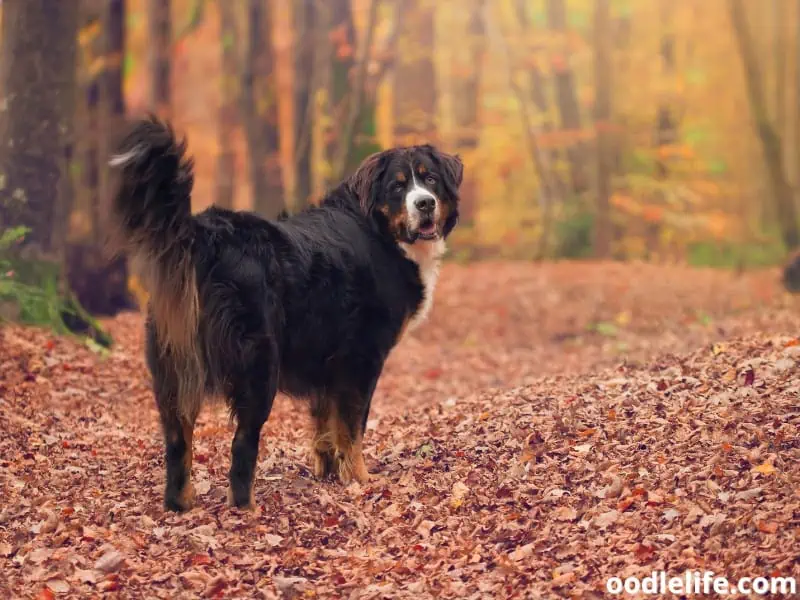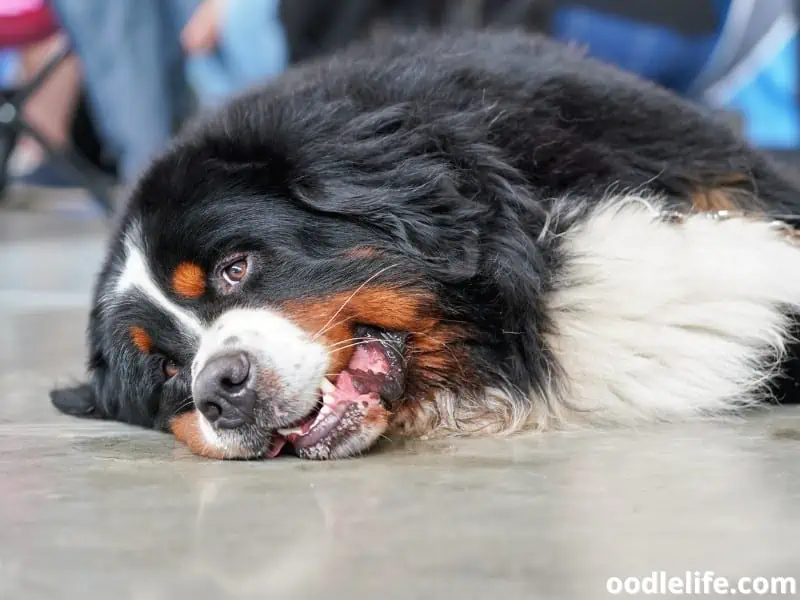When Do Bernese Mountain Dogs Go into Heat?
Bernese Mountain Dogs, like all breeds, have their own specific traits and behaviors that, as an owner, one should be familiar with, especially when it comes to heat cycles. For female Bernese Mountain Dogs, understanding their heat cycle is an essential aspect of caring for their health and well-being. Knowing when your Bernese Mountain Dog goes into heat and how to identify the signs can help you provide the best care and avoid unnecessary stress or complications.
The heat cycle in Bernese Mountain Dogs may vary slightly from individual to individual, but generally, these dogs have their first heat between 6 to 12 months of age. After their first heat, they tend to experience a heat cycle approximately every 6 months.

It’s essential to monitor your dog’s physical and behavioral changes during this time to support her through this phase effectively.
Key Takeaways
- Be observant of your Bernese Mountain Dog’s heat cycle, which typically begins between 6 to 12 months of age.
- Regularly monitor physical and behavioral changes in your dog during their heat cycle to provide proper care.
- Familiarize yourself with signs of heat and provide care accordingly, including potentially spaying if you don’t plan on breeding your Bernese Mountain Dog.
Understanding Bernese Mountain Dogs and Heat

Breed Characteristics
Bernese Mountain Dogs are considered a large breed, typically weighing between 70-120 pounds. Like most larger dogs, they have a slower growth rate than smaller breeds, with some taking up to three years to reach their full size. These gentle giants are often considered friendly and easygoing, but like any dog, they experience heat cycles.
Age of Maturity
When it comes to Bernese Mountain Dog maturity, every individual might be slightly different. On average, they reach sexual maturity around 12-18 months of age. However, this can vary due to factors such as size, genetics, and overall health.
It’s important to be vigilant and pay attention to your dog’s behavior and physical changes, as these can be indicators of the onset of their first heat cycle.
Heat Cycle Duration
The heat cycle of a Bernese Mountain Dog usually lasts between 2-4 weeks, with most cycles occurring twice per year. However, this can vary from dog to dog and even change as they age. The heat cycle can be broken down into several stages:
Proestrus (1-3 weeks): This marks the beginning of the heat cycle, so keep an eye out for swelling in the vulva and bloody discharge. Your dog may also show some mood swings and be more clingy.
Estrus (5-14 days): During this time, a female Bernese Mountain Dog is fertile and receptive to mating. Discharge might lighten in color and decrease in quantity.
Diestrus (2-3 months): In this stage, your dog’s body starts returning to normal, and she is no longer fertile. Hormonal changes take place in preparation for a potential pregnancy.
Keep in mind that each Bernese Mountain Dog is unique, and their heat cycles may not be precisely the same as others. Consulting with a veterinarian is always advisable to better understand your dog’s specific needs and establish a proper care plan. So, while you can look forward to many snuggles and good times with your furry friend, always remain vigilant about their heat cycle to ensure their well-being.
Identifying Signs of Heat in Your Bernese Mountain Dog

Physical Signs
One of the first signs that your Bernese Mountain Dog is entering heat (estrus) is a noticeable change in the appearance of their vulva. You’ll likely observe a swollen vulva which can be accompanied by a bloody discharge. This discharge is more visible in the proestrus stage and may gradually become lighter in color as they enter the estrus phase.
Keeping an eye out for these physical signs can help you to better care for your dog during this time, making both their life and yours a little easier to manage.
Another physical sign to watch for is excessive urination. Your Bernese Mountain Dog will be marking their territory and trying to catch the attention of potential mates. It’s not just a ploy to get more walks and car rides, although it might seem that way at first!
Behavioral Signs
Now that we’ve covered the physical signs, let’s talk about the behavior of your Bernese Mountain Dog during heat. During this time, your usually laid-back, lovable friend may undergo some significant behavioral changes. For example, female dogs might become more aggressive or agitated, whereas they might normally be as placid as a mountain lake.
This aggression can be a way for them to protect themselves from unwanted male attention.
Speaking of male attention, your Bernese Mountain Dog is likely to attract a male canine audience during her heat. Male dogs will be drawn to her scent and may become exceptionally interested in your dog during walks. Keeping your dog on a leash during this time can help to manage these encounters and keep any romantic liaisons at bay.
On the more affectionate side of the behavioral spectrum, your Bernese Mountain Dog may become extra clingy and seek more attention from you, the owner. This is a time when the phrase “dogs are man’s best friend” has never been truer. They might become very affectionate, wanting to be near you constantly.
Although this can be endearing, it’s important not to encourage overly aggressive or excessively needy behavior.
In conclusion, as a responsible Bernese Mountain Dog owner, it’s your job to recognize the signs of heat and provide the appropriate care. Keep an eye on physical signs, like a swollen vulva and vaginal discharge, while navigating any potential behavioral changes during this time. Don’t hesitate to consult with your vet if you have concerns or questions, as they can guide you through this delicate period in your dog’s life.
Remember to exercise plenty of patience and understanding, and your furry friend will be back to her normal self in no time. Good luck, and may the odds be ever in your favor–or at least in your clean-up efforts!
Caring for Your Bernese Mountain Dog in Heat
When your female Bernese Mountain Dog (or “Bernie Girl”) goes into her first heat cycle, it can be a confusing and challenging time for both of you. Fear not, faithful dog parent – we’ve got your back with the most practical tips and information to navigate this phase like a pro!

Managing Behavioral Changes
During the heat cycle, which typically begins around six months of age and lasts two to four weeks, you may notice some mood swings and changes in your dog’s behavior. Don’t let this scare you – your Bernese girl might just be feeling a little skittish or anxious. Remember, she’s going through a hormonal rollercoaster ride!
Woof, am I right?
Here are some quick pointers:
- Exercise: Keep up with regular exercise, but make sure not to overdo it in hot weather as Berners are sensitive to heat. Also, avoid dog parks or other areas with male dogs.
- Obedience: Reinforce obedience training and work on any necessary behavior adjustments during this time.
Maintaining Health and Hygiene
While your Bernie girl is in heat, she will experience bleeding or discharge. Maintaining proper health and hygiene is essential to help her feel comfortable and prevent potential infections.
- Place towels on the area where your dog rests to protect your floors and furniture.
- Regularly check for excessive licking that might indicate an infection. If you notice anything unusual, consult your veterinarian.
- While we can’t all be supermodels, it’s essential to keep the area clean. You might need to trim the fur around her reproductive organs to make it easier to maintain cleanliness.
Preventing Unwanted Pregnancy
While your dog is going through her heat cycle, she’ll likely be extra receptive to the attention of male dogs (who’ll almost certainly come sniffing around!). Here are some tips to prevent unwanted breeding:
- Keep your Bernie girl indoors or in a secure backyard when she’s in oestrus (the phase of the cycle when she is most fertile, usually between proestrus and diestrus).
- Avoid dog shows and outdoor gatherings where there are other dogs.
- Monitor your dog closely when outdoors to prevent unexpected encounters with male dogs.
While we all love puppies, it’s essential to consider spaying your dog if you don’t plan on breeding her. This can help reduce the risk of mammary cancer and uterine infections.
So there you have it! By following these simple yet crucial steps, both you and your Bernese Mountain Dog can handle her heat cycle with grace, humor, and a whole lot of tail wags. Remember, this too shall pass, and your beautiful Bernie girl will be back to her normal self in no time!
Considering Spaying Your Bernese Mountain Dog

Benefits of Spaying
Spaying your Bernese Mountain Dog has several health and behavioral benefits. For starters, spayed female dogs are less likely to develop mammary cancer and uterine infections which could be life-threatening.
Not only does spaying eliminate the risk of unwanted pregnancies, but it also avoids the complications of the heat cycle such as mood swings, attracting male dogs, and spotting. Plus, your clean carpets will thank you for avoiding those messy situations.
On a lighter note, spaying can tone down certain behaviors in female dogs. For example, you might find that your Bernese Mountain Dog becomes calmer and less prone to wandering off in search of a mate.
When to Spay?
Deciding when to spay your Bernese Mountain Dog involves considering factors such as age and the dog’s heat cycle. Female dogs typically have their first heat between 6 and 24 months of age, and Bernese Mountain Dogs tend to fall within the later end of the spectrum, around 12 to 18 months. Their heat cycles usually occur once or twice a year, often in the spring.
It’s essential to consult your veterinarian to determine the best time to spay your dog. Some veterinarians recommend spaying before the first heat cycle to maximize the health benefits and reduce the risk of cancer. However, others may advise waiting until the dog is more mature, particularly for a large breed like Bernese Mountain Dogs.
Once your Bernese Mountain Dog is spayed, remember to adjust their exercise and calorie intake accordingly. As spayed dogs may have a lower metabolism, your fluffy friend should be kept active and not fed any of those sneaky table scraps, no matter how convincing their puppy dog eyes may be!
So, go ahead and have a chat with your trusted veterinarian about spaying your Bernese Mountain Dog. Taking everything into account, you’ll be able to make an informed decision that works best for your doggo and keeps them happy, healthy, and, well, less driven to turn your home into a canine Love Island!
Frequently Asked Questions
How long does heat last for Bernese Mountain dogs?
Heat cycles in Bernese Mountain dogs generally last about 2 to 4 weeks. However, it is important to note that the duration can vary among individual dogs.
How often do Bernese Mountain dogs experience heat?
Bernese Mountain dogs usually experience heat cycles every 6 to 8 months. Keep in mind that the frequency may vary depending on individual factors, such as the dog’s age and overall health.
What age should a Bernese Mountain dog be spayed?
Veterinarians usually recommend spaying a Bernese Mountain dog before their first heat cycle, often around 6 months of age. Spaying at this age reduces the risk of mammary cancer and other reproductive health issues in the future.
What are signs of a dog entering heat?
Some signs of a dog entering heat include swollen vulva, bloody discharge, increased urination, and behavioral changes such as increased clinginess or aggression. Keep an eye out for these indicators to determine if your Bernese Mountain dog may be entering her heat cycle.
Do Bernese Mountain dogs have a specific heat schedule?
While there isn’t a specific heat schedule for all Bernese Mountain dogs, they generally experience their heat cycles every 6 to 8 months. Regularly observing and noting your dog’s behavior can help you keep track of her individual cycle.
Are there any unique heat-related behaviors in Bernese Mountain dogs?
Bernese Mountain dogs may exhibit unique behaviors during their heat cycles, such as being more affectionate, restless, or displaying signs of discomfort. While these behaviors can be seen in other dog breeds as well, it’s important to know and understand your dog’s specific signs and behavioral changes during her heat cycle.